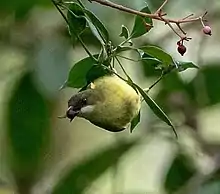| Mindanao white-eye | |
|---|---|
 | |
| Scientific classification | |
| Domain: | Eukaryota |
| Kingdom: | Animalia |
| Phylum: | Chordata |
| Class: | Aves |
| Order: | Passeriformes |
| Family: | Zosteropidae |
| Genus: | Heleia |
| Species: | H. goodfellowi |
| Binomial name | |
| Heleia goodfellowi (Hartert, 1903) | |
The Mindanao white-eye (Heleia goodfellowi), also known as the black-masked white-eye, is a species of bird in the family Zosteropidae. The specific epithet honours British zoological collector Walter Goodfellow. It is endemic to the Philippines. Its natural habitat is subtropical or tropical moist montane forest.
Description and taxonomy
EBird describes the bird as "A fairly small bird of montane forest on Mindanao. Olive on the upperparts, darker in the wing and tail, with a blackish mask, dingy yellow underparts, and a pale gray throat. Usually found in mixed-species flocks with Cinnamon ibon, Warbling white-eye, and Black-and-cinnamon fantail. Similar to Yellow-bellied whistler, but usually found at higher elevations, and has a thinner bill and dark mask. Gives a musical whistle and also a harsh grating call."[2]

Subspecies
Three subspecies are recognized:
- Heleia goodfellowi goodfellowi - Central and South Mindanao
- Heleia goodfellowi gracilis- North East Mindanao
- Heleia goodfellowi malindangensis- West Mindanao
and an undescribed subspecies in South East Mindanao[3]
Habitat and conservation status

It inhabits tropical moist primary and secondary sub-montane and montane forest and forest edge from 1,250 - 2,400 meters above sea level.
IUCN has assessed this bird as a least-concern species. Despite a limited range, it is said to be locally common in its range. As it occurs in rugged and inaccessible mountains, this has allowed a large portion of its habitat to remain intact. It is also able to tolerate degraded forest. However, the population is still said to be declining, as it is still affected by habitat loss through deforestation, mining, land conversion and slash-and-burn - just not to the same extent as lowland forest. [4]
References
- ↑ BirdLife International (2016). "Heleia goodfellowi". IUCN Red List of Threatened Species. 2016: e.T22714303A94410820. doi:10.2305/IUCN.UK.2016-3.RLTS.T22714303A94410820.en. Retrieved 13 November 2021.
- ↑ "Mindanao White-eye". Ebird.
- ↑ Allen, Desmond (2020). Birds of the Philippines. Barcelona: Lynx and Birdlife International Field Guides. pp. 296–297.
- ↑ International), BirdLife International (BirdLife (1 October 2016). "IUCN Red List of Threatened Species: Dicaeum nigrilore". IUCN Red List of Threatened Species. Retrieved 9 September 2021.
